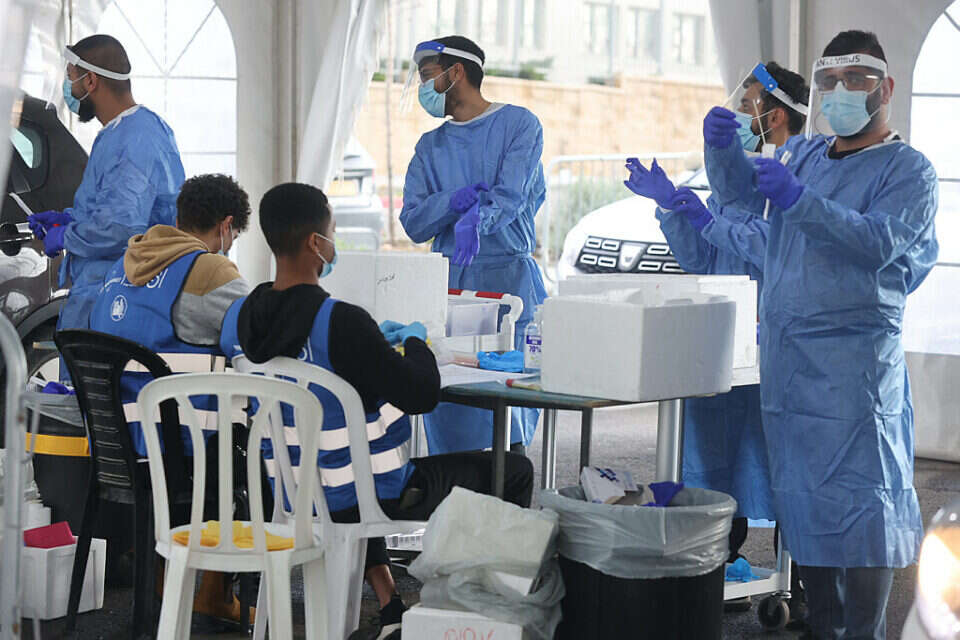The Prime Minister is proud that the State of Israel has made efforts and "bought time" of about a month and a half to prepare for the treatment of the Omicron variant, but data presented today (Monday) in a briefing by Home Front Command reporters did not strengthen investigations and laboratories.
However, the sampling teams for the corona tests were doubled, and a "bot" was used for automatic investigations.
The headquarters' actions, in locating variants among positives returning from abroad and in investigations through special investigative teams of Alon Headquarters, led to the delay of the entry of the Omicron strain and the slowdown in its spread in Israel. - compared to about 1,500-1,000 researchers in previous waves, and even a record of 3,000 researchers.
"It's relatively small, but they do first-line investigations and the focus is on at-risk populations, adults and medical staffs. Up to 3,000 are verified per day, can be interrogated by the 600 investigators currently in command," a Home Front Command source said.
The investigation bot
The investigations conducted on WhatsApp using the "investigation bot" began operating as early as last August but became operational only in the run-up to the Omicron wave.
At the Alon headquarters, we noted that "when the number increases beyond 3,000 verified, the bot is put into action. These days, it is likely that anyone who is not part of the population set for us to target will only be questioned by the bot."
For this reason, these investigations do not take place in schools.
According to data from Alon Headquarters, 30-50% of the population surveyed using the bot cooperate in the investigation.
"The Ministry of Health is guiding us regarding the investigations. We are not deciding on the policy. We have a limited number of investigators and we will not be able to 'chase' after anything verified, because the wave will wash us away."
Why was the time not taken to increase the amount of researchers?
A source in the Home Front Command: "Training a researcher takes two to three months, and a researcher is needed to train him. We do not replace a fighter on the battlefield. It is important to create stability. We decided to make every effort with what we have, and concentrated effort on the bot.
"Laboratories
have reached the limit of capacity"
The capabilities of the State of Israel today are 250,000 PCR tests and another 200,000 institutional antigen tests.
In the last wave, the previous record set on New Year's Eve was broken, when 230,000 PCR tests were performed.
The Home Front Command noted that the congestion creates "traffic jams" in five laboratories with which the state works.
One of the tasks of Alon Headquarters is to regulate the load between the laboratories.
The average waiting time for a result today, when there are more than 200,000 tests, is 48 hours - but the goal is 24 hours, a goal that can be reached when there are up to 170,000 tests.
"These days are defined as a period of adaptation to the antigen, and yet a citizen who arrives at a sampling station can be sampled by PCR," the Home Front Command stressed, noting that at the moment the adaptation is not limited in time.
Why was the month not used to strengthen the laboratories?
"The existing laboratories today have reached the limit of capacity," the Home Front Command said, "and the only option is to set up more laboratories - at least within a month, at the fastest pace. When we built the reference scenario, we prepared for 200,000 people." "We are in the middle of the fighting and the question is what to focus on, how to manage and regulate. It takes half a year to set up a laboratory."
Regarding solutions such as pool collection - a technology that combines tests from about ten subjects, and only if there is one positive repeat of the test - a Home Front Command source noted that at a higher morbidity rate of more than 6%, this is inefficient and causes additional work for laboratories.
Brigadier General Shlomi Ben Mocha, Commander of the Alon Headquarters, Photo: Yoav Ari Dodkevitz
Focus: people aged 60 and over and populations at risk
These days, the Alon headquarters and the Home Front Command are busy addressing the challenges of the fifth wave of the Corona, focusing on at-risk populations - both in PCR tests for the elderly population and in activities in nursing homes.
"We are targeting 60-plus-year-olds and at-risk populations. That name is net life-saving," a Home Front Command source said.
Among other things, 132 medics were recruited from the IDF to assist the HMOs, the hospitals will be reinforced with military units that will assist in the day-to-day operations in the face of a wave of isolation and staff illness, and the Home Front Command will increase Magen Avot by 40 medics.
Next week, a "strong stand" campaign will begin in Petah Tikva, to vaccinate the city's population.
The operation, which is shared by the Home Front Command and the municipality, will make messages and vaccines accessible so that the population can reach the wave of the omicron as protected as possible.
This operation will continue in other cities with a high rate of at-risk populations aged 60 and over, alongside a low immunization rate.
According to the commander of the Alon headquarters, Brigadier General Shlomi Ben Mocha, who took office on the eve of the Omicron wave about a month ago, "We are working to target 60-plus-year-olds and at-risk populations to reduce the morbidity.
The focus of the effort is in the world of investigations to cut the chain, and in the world of sampling, which are the first in the chain to get the answer. "
Were we wrong?
Fixed!
If you found an error in the article, we'll be happy for you to share it with us

